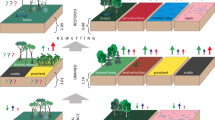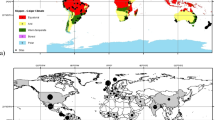Abstract
To predict future spatio-temporal patterns of climate change, we should fully understand the spatio-temporal patterns of climate change during the past millennium. But, we are not yet able to delineate the patterns because the qualities of the retrieved proxy records and the spatial coverage of those records are not adequate. Northern Xinjiang of China is one of such areas where the records are not adequate. Here, we present a 500-yr land-surface moisture sequence from Heiyangpo Peat (48.34°N, 87.18°E, 1353 m a.s.l) in the southern Altai Mountains within northern Xinjiang. Specifically, peat carbon isotope value of cellulose (δ13Ccellulose) was used to estimate the warm-season moisture variations and the degree of humification was used to constrain the δ13Ccellulose-based hydrological interpretation. The climatic attributions of the interpreted hydrological variations were based on the warm-season temperature reconstructed from Belukha ice core and the warm-season precipitation inferred from the reconstructed Atlantic Multidecadal Oscillations (AMO). The results show that humification decreased and the δ13Ccellulose-suggested moisture decreased from ~1510 to ~1775 AD, implying that a constant drying condition may have inhibited peat decay. Our comparison with reconstructed climatic parameters suggests that the moisture-level decline was most likely resulted from a constant decline of precipitation. The results also show that humification kept a stable level and the δ13Ccellulose-suggested moisture also decreased from ~1775 to ~2013 AD, implying that peat decay in the acrotelm primarily did not depend on the water availability or an aerobic environment. Again, our comparison with reconstructed climatic parameters suggests that the land-surface moisturelevel decline was most likely resulted from a steady warming of growing-season temperature.
Similar content being viewed by others
References
Aaby B, Tauber H (1975) Rates of peat formation in relation to degree of humification and local environment, as shown by studies of a raised bog in Denmark. Boreas 4: 1–17. https://doi.org/10.1111/j.1502-3885.1975.tb00675.x
Aizen VB, Aizen EM, Joswiak DR, et al. (2006) Climatic and atmospheric circulation pattern variability from ice-core isotope/ geochemistry records (Altai, Tian Shan and Tibet). Annals of Glaciology 43(1): 49–60. https://doi.org/10.3189/ 172756406781812078
Batima P, Natsagdorj L, Gombluudev P, et al. (2005) Observed climate change in mongolia, assessments of impacts and adaptations to climate change working paper, 26
Blackford J, Chambers F (1993) Determining the degree of peat decomposition for peat-based palaeoclimatic studies. International Peat Journal 5: 7–24
Blaauw M (2010) Methods and code for ‘classical’ agemodelling of radiocarbon sequences. Quaternary Geochronology 5: 512–5128. https://doi. org/10.1016/j.q uageo.2010.01.002
Castro D, Souto M, Garcia-Rodeja E, et al. (2015) Climate change records between the mid- and late Holocene in a peat bog from Serra do Xistral (SW Europe) using plant macrofossils and peat humification analyses. Palaeogeography Palaeoclimatology Palaeoecology 420: 82–95. https://dx.doi.org/10.1016/j.palaeo.2014.12.005
Chambers FM, Beilman DW, Yu Z, (2011) Methods for determining peat humification and for quantifying peat bulk density, organic matter and carbon content for palaeostudies of climate and peatland carbon dynamics. Mires Peat 7: 1–10. http://www.mires-and-peat.net/ Available on: http://miresand-peat.net/pages/volumes/map07/map0707.php
Chen F, Yuan YJ, Chen FH, et al. (2013) A 426-year drought history for Western Tian Shan, Central Asia, inferred from tree rings and linkages to the North Atlantic and Indo-Pacific oceans. Holocene 23: 1095–1104. https://doi.org/10. 1177/0959683613483614
Chen F, Yuan Y, Zhang T, et al. (2016a) Precipitation reconstruction for the northwestern Chinese Altay since 1760 indicates the drought signals of the northern part of inner Asia. International Journal of Biometeorology 60(3): 455–463. https://doi.org/10.1007/s00484-015-1043-5
Chen F, Yuan Y, Davi N, et al. (2016b) Upper Irtysh River flow since AD 1500 as reconstructed by tree rings, reveals the hydroclimatic signal of inner Asia. Climatic Change 139(3–4): 651–665. https://doi.org/10.1007/s10584-016-1814-y
Chen X (2010) Physical Geography of China’s Arid Zones, Science Press, Beijing. (in Chinese)
Chen YN, Yang Q, Luo Y, et al. (2012) Ponder on the issues of water resources in the arid region of northwest China. Arid Land Geography 35(1): 1–9. (in Chinese) https://doi.org/10.13826/j.cnki.cn65-1103/x.2012.01.007
Eichler A, Oliver S, Henderson K, et al. (2009) Temperature response in the Altai region lags solar forcing. Geophysics Research Letters 36: L01808. https://doi. org/10.1029/2008GL035930
Fei J, Wu ZH, Huang JP, et al. (2014) Evolution of land surface air temperature trend. Nature Climate Change 4(6): 462. https://doi.org/ 10.1038/NCLIMATE2223
Gray ST, Graumlich LJ, Betancourt JL, et al. (2004) A tree-ring based reconstruction of the Atlantic Multidecadal Oscillation since 1567 AD. Geophysic Research Letters 31: L12205. https://doi.org/10.1029/2004GL019932
Green JW (1963) Wood cellulose. In Whistler, R.L., editor, Methods in carbohydrate chemistry, vol. 3, Academic Press, New York.
Hong B, Gasse F, Uchida M, et al. (2014) Increasing summer rainfall in arid eastern-Central Asia over the past 8500 years. Scientific Reports 4: 5279. https://doi.org/10.1038/srep0 5279
Hong YT, Hong B, Lin QH, et al. (2003) Correlation between Indian Ocean summer monsoon and North Atlantic climate during the Holocene. Earth and Planetary Science Letters 211: 371–380. https://doi.org/10.1016/S0012-821X(03)00207-3
Hong YT, Hong B, Lin QH, et al. (2005) Inverse phase oscillations between the East Asian and Indian Ocean summer monsoons during the last 12000 years and paleo-El Niño. Earth Planetary Science Letters 231: 337–346. https://doi.org/10.1016/j.epsl.2004.12.025
Hong YT, Wang ZG, Jiang HB, et al. (2001) A 6000-year record of changes in drought and precipitation in northeastern China based on a δ13C time series from peat cellulose. Earth Planetary Science Letters 185: 111–119. https: //doi.org/10.1016/S0012-821X(00)00367-8
Huang C, Li YH, Guo WK, et al. (2015) The experimental methods of extraction α–cellulose in peat samples. Arid Land Geography 38(4): 728–734. (In Chinese)
Huang JP, Yu HP, Guan XD, et al. (2015) Accelerated dryland expansion under climate change. Nature Climate Change 6: 166–171. https://doi.org/10.1038/NCLIMATE2837
Huang T, Cheng SG, Mao XM, et al. (2013) Humification degree of peat and its implications for Holocene climate change in Hani peatland, Northeast China. Chinese Journal of Geochemistry 32 (4): 406–412. https://doi.org/10.1007/ s11631-013-0649-8
Keeling CD, Piper SC, Bacastow RB, et al. (2005) Atmospheric CO2 and 13CO2 exchange with the terrestrial biosphere and oceans from 1978 to 2000: Observations and carbon cycle implications. In: Ehleringer JR, Cerling TE and Dearing MD (eds) A History of Atmospheric CO2 and Its Effects on Plants, Animals, and Ecosystems. Springer Verlag, New York, 83–113.
Kutzbach JE, Chen G, Cheng H, et al. (2014) Potential role of winter rainfall in explaining increased moisture in the Mediterranean and Middle East during periods of maximum orbitally-forced insolation seasonality. Climate Dynamics 42(3–4): 1079–1095. https://doi.org/10.1007/s00382-013- 1692-1
IPCC (2014) In: Stocker, T.F., Qin, D.H., Plattner, G.K., Tignor, M., Allen, S.K., Boschung, J., Nauels, A., Xia, Y., Bex, V., Midgley, P.M. (Eds.), Climate Change 2013: the Physical Science Basis. Working Group I Contribution to the Fifth Assessment Report of the Intergovernmental Panel on Climate Change. Cambridge University Press, Cambridge, United Kingdom and New York, NY, USA
Lan B, Zhang DL, Yang YP (2017) Evolution of Lake Ailike (northern Xinjiang of China) during past 130 years inferred from diatom data. Quaternary International. https:// doi.org/10.1016/j.quaint.2016.11.014
Lee X, Feng Z, Guo L, et al. (2005) Carbon isotope of bulk organic matter, a proxy for precipitation in the arid and semiarid central East Asia. Global Biogeochemical Cycles 19: GB4010. https://doi.org/10.1029/2004GB002303
Lu R, Dong B, Ding H (2006) Impact of the Atlantic Multidecadal Oscillation on the Asian summer monsoon. Geophysical Research Letters 33: L24701. https: //doi.org/10.1029/2006GL027655
Ma JY, Sun W, Liu XN, et al. (2012) Variation in the Stable Carbon and Nitrogen Isotope Composition of Plants and Soil along a Precipitation Gradient in Northern China. PLoS ONE 7(12): e51894. https://doi.org/10.1371/journal.pone.0051894
Ma JY, Chen FH, Zhang HW, et al. (2007) Spatial distribution characteristics of stable carbon isotope compositions in desert plant Reaumuria soongorica. Frontier Earth Science China 1(2): 150–156. https://doi.org/10.1007/s11707-007-0019-0
MacFarling MC, Etheridge D, Trudinger C, et al. (2006) Law Dome CO2, CH4 and N2O ice core records extended to 2000 years BP. Geophysical Research Letters 33: L14810. https://doi.org/10.1029/2006GL026152
Mann ME, Zhang Z, Rutherford S, et al. (2009) Global signatures and dynamical origins of the Little Ice Age and Medieval Climate Anomaly. Science 326: 1256–1260. https://doi.org/ 10.1126/science.1177303
Mariotti A (2007) How ENSO impacts precipitation in southwest central Asia. Geophysical Research Letters 34(16): L16706. https://doi.org/10.1029/2007GL030078
McCarroll D, Loader NJ (2004) Stable isotopes in tree rings. Quaternary Science Reviews 23: 771–801. https://doi.org/10.1016/j.quascirev.2003.06.017
Ménot G, Burns SJ (2001) Carbon isotopes in ombrogenic peat bog plants as climatic indicators, calibration from an altitudinal transect in Switzerland. Organic Geochemistry 32: 233–245. https://doi.org/10.1016/S0146-6380(00)00170-4
Mohino E, Janicot S, Bader J (2011) Sahel rainfall and decadal to multi-decadal sea surface temperature variability. Climate dynamics 37: 419–440. https://doi.org/10.1007/s00382-010- 0867-2
Nurbayev A, Niels T, Altai A, et al. (2008) Peanlands of the Chinese Altay. Peatlands International 2: 25–28.
Payne R, Blackford J (2008) Peat humification and climate change: a multi-site comparison from mires in south-east Alaska. Mires Peat 3: 1–11
R development core team (2013) RA Lang Environ Stat Comput 55: 275–286
Raghoebarsing AA, Smolders AJP, Schmid MC, et al. (2005) Methanotrophic symbionts provide carbon for photosynthesis in peat bogs. Nature 436(7054): 1153. https://doi.org/ 10.1038/nature03802
Ran M, Feng ZD (2013) Holocene moisture variations across China and driving mechanisms: a synthesis of climatic records. Quaternary International 313/314: 179–193. https://doi.org/10.1016/j.quaint.2013.09.034
Ran M, Zhang CJ, Feng ZD (2015) Climatic and hydrological variations during the past 8000 years in northern Xinjiang of China and the associated mechanisms. Quaternary International 358: 21–34. https://doi.org/10.1016/j.quaint. 2014.07.056
Reimer PJ, Bard E, Bayliss A, et al. (2013) IntCal13 and Marine13 radiocarbon age calibration curves, 0–50,000 years cal BP. Radiocarbon 55: 1869–1887. https://doi.org/10.2458/ azu_js_rc.55.16947
Royles J, Horwath AB, Griffiths H (2014) Interpreting bryophyte stable carbon isotope composition: plants as temporal and spatial climate recorders. Geochemistry, Geophysics, Geosystems 15:1462–1475. https://doi.org/10. 1002/2013GC005169
Salnikov V, Turulina G, Polyakova S, et al. (2015) Climate change in Kazakhstan during the past 70 years. Quaternary International 358: 77–82. https://doi.org/10.1016/j.quaint. 2014.09.008
Sorg A, Bolch T, Stoffel M, et al. (2012) Climate change impacts on glaciers and runoff in Tien Shan (Central Asia). Nature Climate Change 2: 725–731. https://doi.org/10.1038/ NCLIMATE1592
Sun C, Li J, Zhao S (2015) Remote influence of Atlantic multidecadal variability on Siberian warm season precipitation. Scientific Reports 5: 16853. http:// doi.org/ 10.1038/srep16853
Velasco Herrera VM, Mendoza B, Herrera GV (2015) Reconstruction and prediction of the total solarirradiance: From the Medieval Warm Period to the 21st century. New Astronomy 34: 221–233. https://doi.org/ 10.1016/j.newast.2014.07.009
Wang J, Yang B, Ljungqvist FC, et al. (2017) Internal and external forcing of multidecadal Atlantic climate variability over the past 1,200 years. Nature Geoscience 10(7): 512–517. https://doi.org/10.1038/NGEO2962
Wang H, Hong YT, Zhu YX, et al. (2004) Humification degrees of peat in Qinghai-Xizang Plateau and palaeoclimate change. Chinese Science Bulletin 5: 514–519. https://doi.org/10.1360/ 03wd0584
Wang H, Hong YT, Lin QH, et al. (2010) Response of humification degree to monsoon climate during the Holocene from the Hongyuan peat bog, eastern Tibetan Plateau. Palaeogeography Palaeoclimatology Palaeoecology 3: 171–177. https://doi.org/10.1016/j.palaeo.2009.12.015
Wang G, Feng X, Han J, et al. (2008) Paleovegetation reconstruction using δ13C of soil organic matter. Biogeosciences 5: 1325–1337. Available on: https://hal. archives-ouvertes.fr/hal-00298000/document
Wang W, Feng ZD (2013) Holocene moisture evolution across the Mongolian Plateau and its surrounding areas: A synthesis of climatic records. Earth-Science Reviews 122: 38–57. https://doi.org/10.1016/j.earscirev.2013.03.005
Wei X, Chen JY (2012) The climatic characters of precipitation in Northern Xinjiang and its response to ENSO. Progress in geophysics 12:753–759. (in Chinese)
Xu CC, Chen YN, Yang YH, et al. (2010) Hydrology and water resources variation and its response to regional climate change in Xinjiang. Journal of Geographical Sciences 20(4): 599–612. https://doi.org/10.1007/s11442-010-0599-6
Xu CC, Li JX, Zhao J, et al. (2015) Climate variations in northern Xinjiang of China over the past 50 years under global warming. Quaternary International 358: 83–92. https://doi.org/10.1016/j.quaint.2014.10.025
Yu SY (2013) Quantitative reconstruction of mid- to late- Holocene climate in NE China from peat cellulose stable oxygen and carbon isotope records and mechanistic models. The Holocene 23(11): 1507–1516. https://doi.org/10. 1177/0959683611425544
Zhang Y, Meyers PA, Liu XY, et al. (2016) Holocene climate changes in the central Asia mountain region inferred from a peat sequence from the Altai Mountains, Xinjiang, northwestern China. Quaternary Science Reviews 152: 19–30. https://doi.org/10.1016/j.quascirev.2016.09.016
Acknowledgement
This research was financially supported by Chinese Natural Science International Cooperation Program Foundation Grant (No. 41361140361), Chinese Natural Science Foundation Grant (No. U1203821L08) and Chinese Academy Sciences International Cooperation Program (No. GJHZ201315). We thank Prof. Nurbayev Abdusalih for his help in identifying plant residues.
Author information
Authors and Affiliations
Corresponding author
Rights and permissions
About this article
Cite this article
Zhang, Dl., Yang, Yp. & Lan, B. Peat humification- and δ13Ccellulose-recorded warm-season moisture variations during the past 500 years in the southern Altai Mountains within northern Xinjiang of China. J. Mt. Sci. 14, 2200–2211 (2017). https://doi.org/10.1007/s11629-017-4538-1
Received:
Revised:
Accepted:
Published:
Issue Date:
DOI: https://doi.org/10.1007/s11629-017-4538-1




